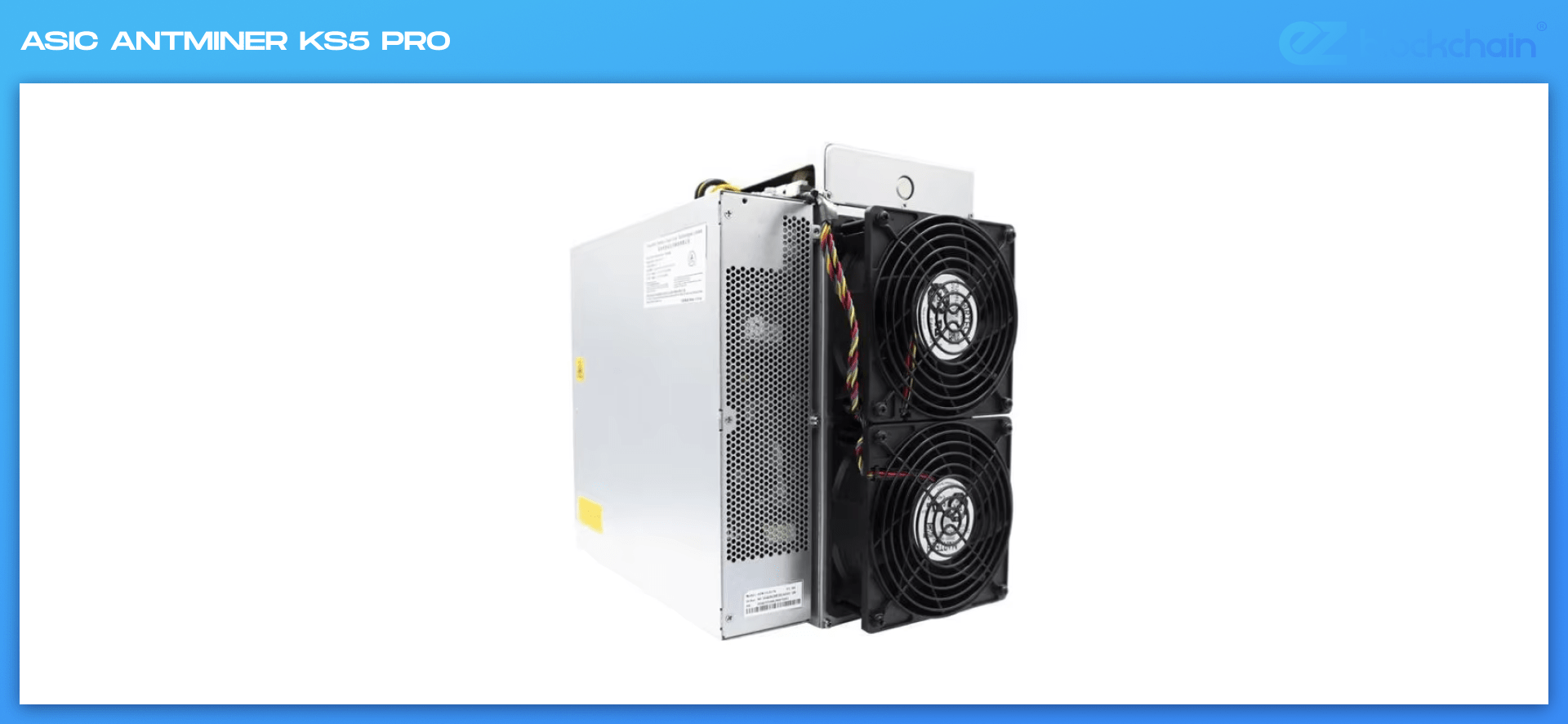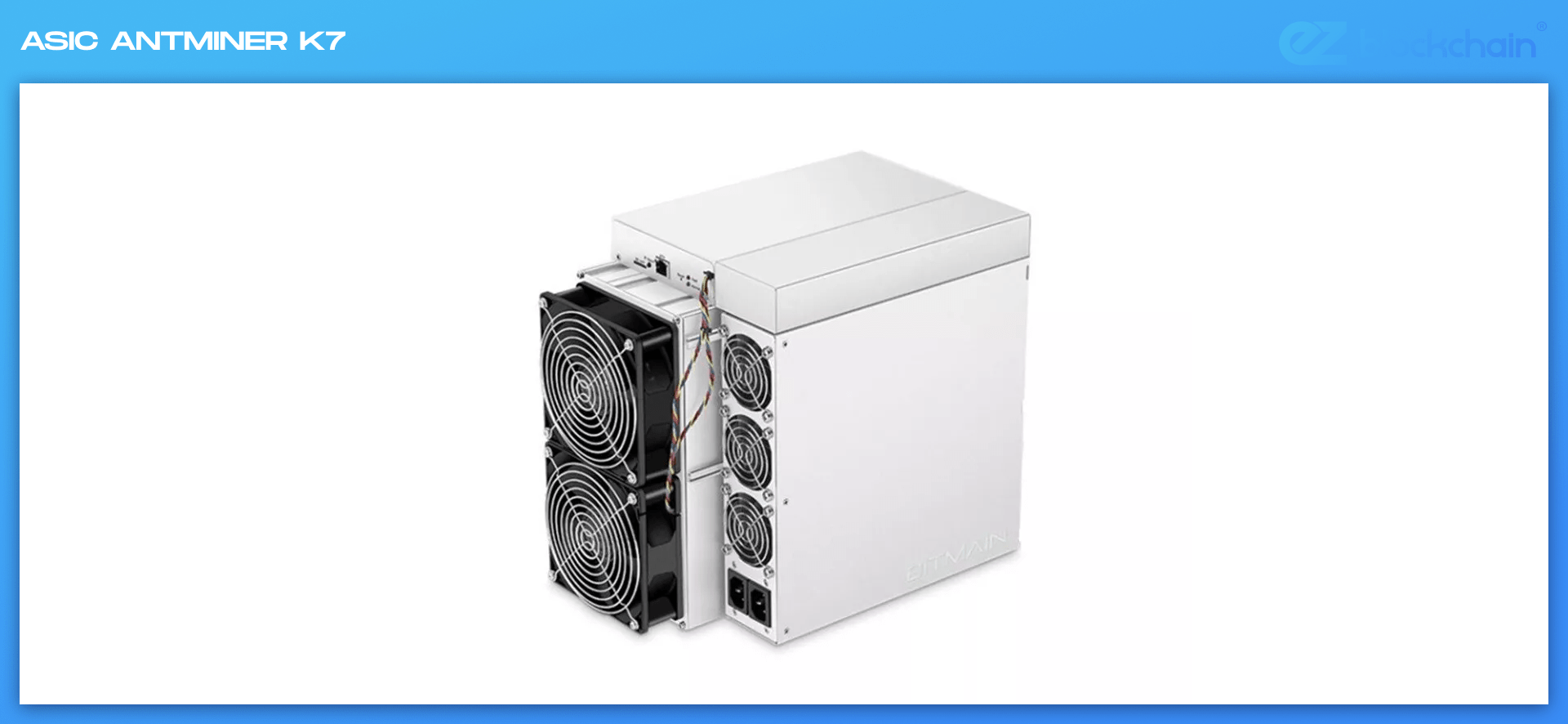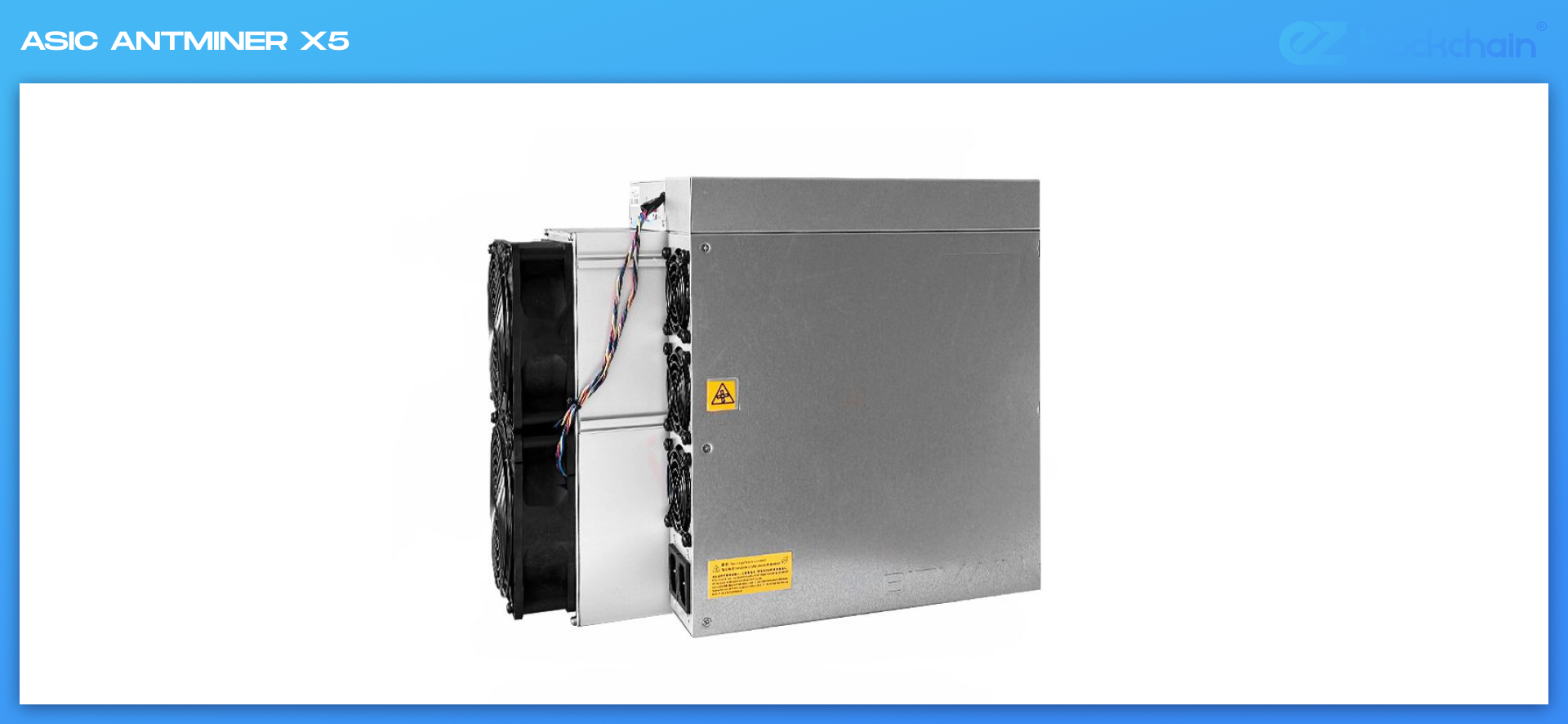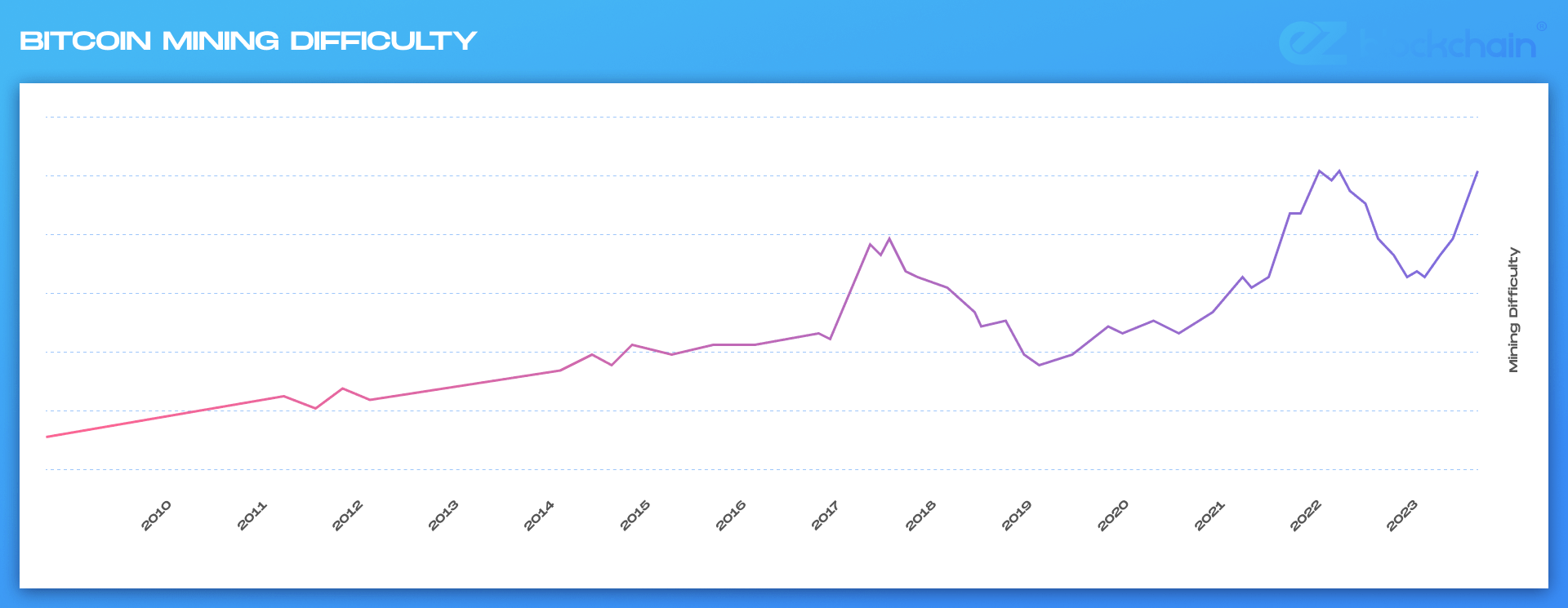Stay up to date with the latest news, announcements, and articles.
But while the global impact of difficulty re-adjustments may be intimidating — don’t fret, we have insights and pro tips to make your life easier!
This article provides an in-depth look at bitcoin mining difficulty explained, how it works, what affects it, and the strategies that miners can employ to adapt to fluctuations in this complex system.
Bitcoin Mining Difficulty Explained
What is bitcoin mining difficulty? Simply put, it is a measure of how hard it is to find a new block in the Bitcoin blockchain. The new difficulty bars are set and automatically re-adjusted approximately every two weeks, or every 2,016 blocks. This mechanism has an in-depth purpose — it helps ensure that blocks are mined roughly every 10 minutes.
The Bitcoin difficulty adjustment process is what powers Bitcoin’s issuance schedule. On top of that, it also helps reinforce the mining network security by making it costly and difficult to attack.
Miners use computational power, or hash rate, to solve complex mathematical problems and eventually mine up some goodies. As the number of miners grows or they upgrade to more efficient hardware, the total hash rate of the network grows as well.
This is where the Bitcoin protocol also employs the mining difficulty raise in order to prevent block generation from accelerating too much. Conversely, if the hash rate drops, as may happen when many miners exit the market, the difficulty adjusts downwards.
However, there’s more to the speed of block generation and block mining difficulty relationship.
Relationship Between Difficulty and Block Generation Time
The main purpose of doing regular BTC network difficulty adjustments is to keep the block time stable at 10 minutes. This is extremely important for Bitcoin’s protocol to run the way it should. When the difficulty is too low for the number of active miners, blocks are generated too quickly.
Too high of a block generation speed thus disrupts Bitcoin’s monetary policy (strict block frequency and regular halving) and transaction verification process (the proof of work protocol may underperform due to overload). But if the difficulty is too high, blocks may be generated too slowly, causing delays in transactions and slowing the entire network.
This is exactly why it is so important to balance out the Bitcoin mining minimum difficulty, keeping it within reasonable boundaries while monitoring the block generation speed and re-configuring it accordingly. So, what is best difficulty in bitcoin mining? It’s the one that maintains optimal block time and aligns with your equipment’s efficiency and the network’s conditions.
Factors Affecting Mining Difficulty
Several factors impact the calculation and fine-tuning of Bitcoin mining difficulty. Here’s a breakdown:
Number of miners and total hash rate
The number of active miners shapes the total hash rate. As more miners join the network, the total computational power gets boosted, which automatically provokes a difficulty raise.
Changes in Bitcoin network activity
Major market events, legal changes, or big BTC price shifts can influence the rates of miners participating in the network. When prices rise, new miners tend to join the network, boosting the difficulty as a result.
Understanding these factors can help miners anticipate mining difficulty adjustments and prepare accordingly. Although the complexity of Bitcoin’s ecosystem makes predicting changes difficult. One may need some auxiliary tools.
- Bitcoin mining difficulty calculator: Miners can use Minerstat’s or other available calculators to estimate the current Bitcoin mining difficulty level and shape their mining expectations based on projected profitability. They can also be used to analyze the difficulty post regular re-adjustments.

Impact of Difficulty on Miners
Difficulty shifts can impact miners’ progress in different ways depending on the type of operation they run. All in all, there are three major risks (sometimes, inevitable consequences)
- Lower earning limit: As difficulty grows, miners may earn fewer bitcoins for the same amount of work, a definite pressure on their bottom line.
- Higher rates of competition: Higher difficulty means more competition for the remaining rewards, often driving smaller or less efficient miners out of the market.
- Increased profitability thresholds: Some miners have a “break-even” difficulty level, where earnings equal operational costs. Difficulty spikes can push them below their profitability threshold, provoking downtime.

Strategies for Miners to Adapt to Difficulty Changes
As you can see, the shifting difficulty situation is a thing to reckon with. And yet it’s just best to be prepared, facing this global mining challenge the right way. For this, miners have developed proven strategies. Here are a couple of pro tips to help counterbalance the challenges that spawn from fluctuating BTC mining difficulty:
Upgrading hardware for better performance
Investing in higher-efficiency mining equipment can help miners counter the rising difficulty. Today’s market offers advanced ASIC miners that consume less power per hash, improving the profit-to-cost ratio even when difficulty grows. Although ASICs can be expensive, the ROI potential is more than decent, and you can choose from a good range of models.
Here is a selection of some of the top models this year in every price segment:
- ASIC Antminer KS5 Pro
-
- Price: $32,299 at a $12,72 profit rate
- Target coin: Kaspa
- Core algorithm: KHeavyRash
- Hashrate: 21000 Gh/s

- ASIC iPollo G1
-
- Price: $8,970 at a $11,33 profit rate
- Target coin: Grin
- Core algorithm: Cuckatoo32
- Hashrate: 36 Gps

- ASIC Antminer K7
-
- Price: $5,399 at a $11,08 profit rate
- Target coin: Nervos
- Core algorithm: Eaglesong
- Hashrate: 63500 Gh/s

- ASIC Antminer X5
-
- Price: $2,099 at a $6,57 profit rate
- Target coin: Monero
- Core algorithm: RandomX
- Hashrate: 212 Kh/s

Joining mining pools for more stable earnings
Mining pools allow both individuals and smaller mining operations and facilities to pool their resources and share rewards. With pools, miners get smaller but more frequent payouts, gaining a chance to achieve the much-desired income stability. One thing you need to mind when joining a pool is the fees that a certain platform may subtract — learn more about how exactly you can choose and join the best mining pool that will help outweigh the total cost of fees with stable profits.
Optimizing energy efficiency
Crypto enthusiasts can transition their mining rig’s power source to renewable energy sources, such as solar or hydroelectric power, to cut down on regular electricity bills and boost profitability in contrast to the potential difficulty spikes. Heat recycling is another method — you can implement heat recycling methods to repurpose waste heat from mining rigs for other operations (e.g., heating buildings or greenhouses), which can help offset costs.
Leveraging financial management tools
Miners can use Bitcoin futures, options, or other derivatives to lock in prices, hedging against potential price drops during high difficulty periods. There are also stablecoin loans and crypto loans available. Borrowing stablecoins or other cryptocurrencies can grant an immediate cash flow to cover operational costs, allowing miners to hold Bitcoin until prices recover or difficulty goes down again.
Extending mining activity across other coins
It’s a good idea to mine altcoins during high difficulty phases. Some ASIC hardware allows mining on different SHA-256 coins. Miners can switch temporarily to altcoins and convert earnings to Bitcoin, stabilizing revenue when Bitcoin difficulty is especially high. Miners can also go for dual mining with compatible coins to double down on their hardware’s versatility. Miners like ASIC Antminer KS5 Pro and other rigs running on the KHeavyRash algorithm support simultaneous mining of multiple cryptocurrencies, granting more income streams.
Going for strategic Bitcoin holdings
Pro tip — seize the moment and accumulate your mining activity during low-difficulty cycles. Miners can increase mining output and set aside reserves for periods of high difficulty. Another pro tip would be to sell strategically — as a miner, you should sell mined Bitcoin when market prices are high to maximize revenue. This will automatically enable you to keep your head above the water during low price periods, resisting income volatility.
Optimizing mining tax strategy
Crypto enthusiasts must deduct operational costs the smart way. They can work with tax professionals to make sure all expenses related to mining operations, such as equipment, power, and maintenance, are correctly deducted to cut down on taxable income. Another way is to structure one’s mining operations as a business entity. By setting up a mining operation as a formal business, miners can sometimes gain access to extra tax incentives and deductions.
Optimizing mining operations further
Last but not least, there are tons of tools for miners to automate mining management — advanced mining management software can be used to, for instance, track profitability and automatically switch to more profitable mining pools or coins. As a global decision, a crypto miner’s owner may want to relocate operations. If possible, moving to regions with lower electricity rates or incentives for mining can lower operational costs and boost one’s sustainability dramatically.
Historical Trends in Bitcoin Mining Difficulty
Bitcoin difficulty explained through the lens of history helps us see how macroeconomic and technological changes affect the mining landscape:
- 2010-2014: Mining difficulty started at 1 and went on a steady increase as Bitcoin’s popularity grew. During this period, the introduction of ASIC mining drastically increased the network’s hash rate.
- 2017: The Bitcoin mining difficulty spiked as Bitcoin reached its first major bull run, and many new participants entered the mining space.
- 2021-2023: Bitcoin experienced a series of price spikes, regulatory pressures, and network re-alignments. As the price rose, so did difficulty, which made many miners upgrade their equipment or join larger pools for stability.

From these historical patterns, it’s clear that mining difficulty explained through consistent analysis can help miners anticipate and adapt to halving events, policy shifts, and profitability trends.
Future Predictions for Mining Difficulty
Looking ahead, Bitcoin mining difficulty is expected to continue its gradual increase due to the following trends:
- Post-halving difficulty spikes: The next Bitcoin halving, scheduled for 2024, will cut down block rewards from 6.25 BTC to 3.125 BTC. Miners will likely experience an increase in competition as they work to capture the remaining rewards.

- Enhanced AI and Machine Learning use: With AI advancements, data analytics tools can better predict difficulty changes, enabling more strategic planning for miners.

- Integration of renewable energy sources: As mining operators seek cost efficiency, the industry is gradually shifting toward renewable energy sources, which can reduce costs and potentially sustain mining operations even as difficulty rises.

We’ll Update Your Equipment to Minimize the Impact of Mining Difficulty
Regular Bitcoin mining difficulty re-adjustment aren’t going anywhere, and it is every miner’s pressing responsibility to adapt to this tendency (read: rule). There are no shortcuts in overcoming this challenge, you can only greet it up in all arms.
Bottom line? The only real reduction in Bitcoin mining difficulty that you can achieve is through technological preparation, research of details, and anticipation of the upcoming changes along with the entire community.
We can assist you with the upgrade of hardware in line with the Bitcoin mining difficulty demands and consult all other related aspects of adapting to the fluctuating crypto mining market. Make sure to contact us for details.
Fill out a form and our bitcoin mining expert will contact you.
FREE CONSULTATIONchoose
a miner
profit and
understand data?
business remotely
with EZ Blockchain?
Fill out a form and our bitcoin mining expert will contact you.









